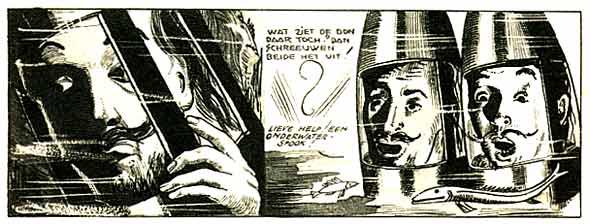Auke Anne Tadema was a pioneer of Dutch science fiction comics, and was mainly active during the 1936-1949 period. He was born in Leeuwarden, Frisia, but spent his childhood in several towns, such as Breda, The Hague, Driebergen and Zutphen. He studied to become a drawing teacher in Amsterdam between 1929 and 1931, and subsequently attended the Rijksacademie voor Beeldende Kunsten until 1934.
Tadema became an advertising illustrator for Rotogravure in Leiden, the publisher of magazines like Unicum and Bravo. Among his first comics were 'De Wonderlijke Ontdekkingsreis van Kleineklant en Bijtetand' in De Groene Amsterdammer (1936) and 'Petertje' in Doe Mee magazine, the children's supplement of Algemeen Handelsblad (1937).
De Wonderlijke Ontdekkingsreis van Kleineklant en Bijtetand
Tadema would become best-known for the science fiction comics he created for the Rotogravure magazine Bravo!, starting with the serial '25 km. onder de Aarde' in 1938. This was followed by Ivanhoe' (1939), 'De spannendste avonturen van Robinson Crusoë' (1939-1942), 'Pim's Wereldreis' (1943) and 'Het mechanisch continent' (1947-1948). Together with Marten Toonder, he was largely responsible for the artwork that appeared in the Dutch edition of Bravo! during the war. Other magazines that published Tadema's work were Vizier ('Hel over Atlantis', 1947), De Prins ('Het mechanisch continent') and De Dikkie Dapper Krant ('Chi-pek-we', 1950-1951).
During the war he mostly lived from his hobby, restoring antique furniture. In 1948 he moved to Brazil, but returned after a year and settled in the city of Heemstede. He has made only a few comics since then. Together with his wife, Bob Tadema-Sporry, he wrote and illustrated many travel stories, that were published in Elseviers Weekblad and Margriet, including the series 'Met de Tadema's op Avontuur' in 1963-64.
25 km onder de aarde
He also illustrated numerous books and made advertising art. His illustrations also appeared in magazines like Margriet, Libelle, Elegance, Vizier and Pep.







